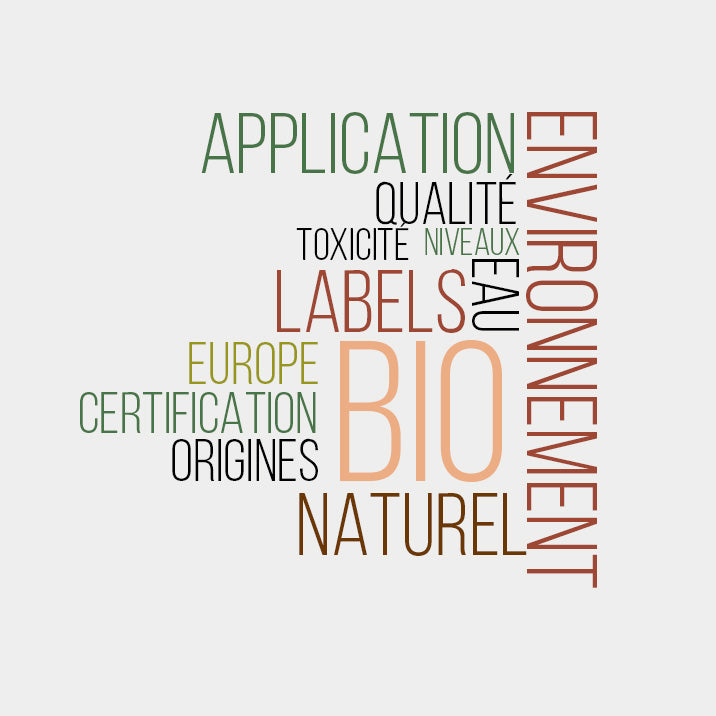
Organic cosmetics and natural cosmetics, how do you find your way?
With the growing complexity of the surrounding world and the various health scandals, we are constantly on the lookout for ways to enable us to appreciate the quality and the safety of our cosmetic products.
So new applications have just appeared - Yuka, What Cosmetic - to meet this demand, without counting of course the multiple labels claiming the organic or natural character that already exist today.
How to make the difference and what to retain on these applications, labels and their repository? We offer you some insights without drowning in the complexity of each.
Organic cosmetics: labels and their rules
Many of labels organic
There are several of them. For each certification body, its reference system - the rules which govern it - and its label! In France, there are at least six. SIf we add our European neighbors, we are in our twenties. The standards differ from one certification body to another and lcertification at a financial and administrative costf quite substantial.
Cing important organizations have teamed up for try as much as possible to reconcile the objectives of each and create between them a single and harmonized repository. A repository called COSMOS was thus created in January 2010, it brings together the organizations Ecocert (France), Cosmebio (France), BDIH (Germany), Soil Association (Great Britain) and ICEA (Italy). The rules of this repository mainly concern the manufacturing, the environmental management, l’Packaging and the composition cosmetics.
Rules not always easy to understand
In particular, it requires that processed ingredients physically at least 95% organic, (such as vegetable oil, essential oil, etc). It also requires thate them chemically processed ingredients are made from agricultural raw materials and manufactured in accordance with the principles of “Green Chemistry”. He imposes that the other ingredients and in particular the preservatives are part of a restrictive list (Synthetic ingredients are not forbidden but limited to a predefined list). He required finally that the content of organic ingredients in the cosmetic product is at least 20%!
You are probably surprised to see an organic content that drops to 20% in your skincare product... VS This is because water, an ingredient found mostly in emulsions (creams, masks, etc.), and mineral ingredients are not inherently organic. So if you remove the water which represents for example approximately 70% in shampoos or shower gels, it will be necessary to calculate the share of organic only in the remaining 30%.
The N labelatural taxe meanwhile a minimum content of at least 95% of ingredients natural and original naturalthe in your cosmetic product.
Un ingredient transformed chemically cannot be organic or natural
To shed light on chemically processed ingredients from’Ingredients natural, take the example of emulsifiers. These ingredients cannot not to be qualified directly as "organic" or "natural" because they are transformed. They can, however, be qualified "of natural origin" When the transformation is done from natural materials. The origin of the raw materials as well as thes procedures transformation are essential because they make it possible to preserve or not the naturalness ! This is where the art and expertise of the person in charge of sourcing and the formulator!
The oils esterified or hydrogenated are another example of a transforming ingredientchemically rmed and accepted in bio. These oils are less expensive than the original vegetable oil, are less susceptible to oxidation and provide a smoother texture. But itThe oils no longer have anything to do with the original vegetable oil because the treatment undergone during their transformation causes them to lose their active ingredients and therefore their effectiveness for the skin.
Remember to read the INCI list, a real vegetable oil is mentioned by the Latin name of its original plant followed by the term " oil ". For example for olive oil, you will have "Olea europaea oil ". For a hydrogenated olive oil, you will have " Hydrogenated olive oil caprylyl esters ”. When vegetable oil is claimed as an active ingredient, it will then be necessary to verify that it exists on the INCI list "Olea europaea oil ". Ask about the virgin or refined quality of the oil. In a refined oil, you lose most of the active ingredients even if it is labeled organic, which is what matters to your skin! If you want to know more about the properties of virgin oils, we tell you in a previous article of the refining of ingredients.
An international standard for natural cosmetics
For’Help the consumer to see more clearly and simpler, une new standard international ISO 16128 entered into force on January 1, 2018. It describes a method for calculating the Natural, Natural, Organic and Organic Origin indices. for the ingredients. It thus presents a framework for determining the Natural Content, Natural Origin, Organic and Organic Origin of the finished product based on the characterization of its ingredients. It is a standard and not a benchmark. EIt therefore does not determine a list of ingredients or a threshold beyond which the product is qualified organic or natural. She does not proscribe no more the use of unwanted ingredients thate you can detectthanks to various mobile applications that have emerged in 2018. Thus for each cosmetic product, it is possible according to this standard toAffix on the packaging its naturalness index based on the natural part of each ingredient in the product.
In addition, a new study report on the claims "Without" should see the light of day for application from July 1, 2019. It states that the labeling should not be misleading and should not be disparaging. Thus the words "without" or "0% parabens, ...", considered denigrating with regard to the cosmetic regulations which authorize their use, could no longer appear on the packaging. The only claims that would be allowed are “alcohol-free” for mouthwashes, “ingredient-free”t of animal origin "for vegans and "acetone-free" to alert consumers reluctant to its scent.
The applications beauty, ainvaluable help to help you find some cosmetics healthy for the skin
In order to improve transparency on the content of cosmetic products, several mobile applications have emerged: Yuka, What Cosmetic, INCI Beauty, Pharmapocket, Cosmethics and CleanBeauty. They shed light on the harmlessness of the components by decoding the undesirable ingredients appearing in INCI language not easily accessible to ordinary people, a trade secret obliges! As an unconventional manufacturer, we give you the keys to deciphering in our item how to decipher the composition of cosmetics. The scoring principle is the same for all. We give you some details below on the two most used applications.
The application Yuka, the one who scanned food, takes on cosmetics
Already well known and widely used in the food sector, in June 2018 it broadened its application to the cosmetics field. This application analyzes the list of components and assigns an overall score based on the presence of irritating, allergenic or toxic ingredients (endocrine disruptors, carcinogens, etc.). A score out of 100 is assigned to each product with a color code ranging from green to red. Any risky components are mentioned to you, thus justifying the overall rating.
The UFC-Que Choisir association is also launching its beauty and skincare application
The application " Quelcosmetic », Launched by UFC-What to Choose, also deciphers the content of your cosmetics for you. It affects an assessment of the potential risk of toxicity of ingredients ranging from green meaning "that no risk has been identified to date" to red for "the existence of a significant risk". On this application, the potential toxicity of the ingredients is analyzed for each type of population: babies, adolescents (3 to 16 years old), pregnant women and adults.
Ratings brought to better decode natural cosmetics
Be careful, however, when interpreting the results. These applications continue theimproveation their analysis software to target the type of population or refine their assessment. Indeed, currently these applications degradent for example lat note in the presence of allergens whatever the origin! Now the presence allergens natural notIt's not necessarily a negative sign. Essential oils, with virtues attested, contain natural allergens obligatorily mentionés in end of listing INCI beyond a certain percentage to inform people potentially allergic. Le regulationst European cosmetics is a security framework which already imposes a maximum concentration. It is the art of the formulator to master their correct dosage for the effectiveness of your products while respecting the limitses imposed by regulations.
Faced with this proliferation of applications, the federation of cosmetics professionals offers application editors to decide together on the analysis methodologies.
In the meantime, on let you discover the beautiful notes and appreciations of our care products on these different applications or on our site, go ahead, to your cellphones!


